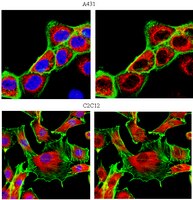MAPK Antibodies, Proteins, Inhibitors, & Assays

Empfohlene Produkte
Überblick
Spezifikationen
Bestellinformationen
Documentation
Verwandte Produkte & Anwendungen
Verwandte Produkte nach: Brand Facete
| Milli-Mark™ |
| Upstate® |
Kategorien
| Life Science Research > Antibodies and Assays > Primary Antibodies |
The Mitogen-Activated Protein Kinase (MAPK) pathways transmit extracellular signals, through receptor tyrosine kinases (RTKs) or integrin stimulation, to both nuclear and cytoplasmic targets. The MAPK signaling cascade transmits and amplifies the signals of extracellular mitogens (growth factors, etc) through the subsequent activation of RTKs. This action creates a signaling cascade of kinases that results in the activation of numerous transcription factors that can permit a cell’s entry into the cell cycle.
The MAPKs are comprised of four distinct families that transduce signals in response to numerous stimuli. They include the classical extracellular signal-related kinase 1 and 2 (ERK 1/2) pathway. The stress-related signaling pathways that encompass both the c-Jun N-terminal Kinase/Stress-Activated protein Kinase (JNK/SAPK) and the p38MAPK pathways. Finally, the fourth MAPK pathwayis the ERK5 (BMK1).
MAPKs are activated in a characteristic and highly specific phospho-relay system composed of three kinases (MEKK, MEK, and MAPK) which phosphorylate/activate each other in the cascading fashion described in the first paragraph. Different stimuli activate different MEKKs, which selectively activate their downstream target (MEK), which then ultimately phosphorylates and activates its MAPK.
MAPK is the most well-characterized signaling pathway in research, yet much is still unknown and ongoing studies for its implications in cancer and neurology continue to proliferate. Millipore is at the forefront of this ongoing research, providing complete solutions for active research in both academic and bio/pharma settings.
The Pathways of MAPK
The ERK pathway is activated by various growth factors (i.e. EGF, FGF, PDGF, VEGF, etc.) and integrin stimulation. The JNK and p38 pathways, also referred to as the stress-related MAPK, are regulated by stress inducing signals such as osmotic stress and UV radiation as well as proinflammatory cytokines such as IL-1 and TNF. It should be noted that although there is selective stimulation of each of these distinct pathways, there also is a great deal of cross-talk between them. For instance, p38- dependent activation of ERK has been demonstrated.
All of the MAPKs (ERK, JNK, p38MAPK, and ERK5) are activated through phosphorylation on both threonine and tyrosine residues at the Thr-X-Tyr dual phosphorylation motif, where X is Glu, Pro, and Gly for ERK, JNK, and p38, respectively. Once phosphorylated and active, they then go on to phosphorylate downstream targets in both the cytoplasm and the nucleus. One of their main targets of MAPK are transcription factors that are activated via this phosphorylation.
Many malignant cancers are characterized by the deregulation of MAPK signaling cascades. Cancerous cells do not respond to cell signaling that would normally result in cell cycle arrest or apoptosis (programmed cell death). In fact, constitutive MAPK signaling contributes to the evolution of some of the most lethal forms of cancer. In some cancers, MAPK is upregulated and results in the migration and invasion of the cancerous cells. Inhibition of the MAPK expression reduces migration and invasion. Many tumors show an increase, sustained activation of this pathway. This is one reason why the MAPK signaling pathway is a highly sought anti-cancer drug target. Among the cellular activities that MAPKs modulate are cell division, proliferation, survival, differentiation, apoptosis, motility and metabolism.
One of MAPK’s most important functions, however, may involve their role in neural function. Although neurons are terminally differentiated, many Erk targets typically thought to mediate the cell cycle are present in these cells. MAPK regulates the phosphorylation of tau and the processing of Ab, both of which are critical to Alzheimer’s Disease pathology. Erk activation is required, not only for certain forms of long-term potentiation (LTP), but also for the acquisition and retention of particular memories. The cellular processes underlying such functions also rely on Erk activation. For example, MEK inhibitors block increases in AMPA Receptor (AMPAR) number and activity, a change thought to underlie learning. Long known to be important for synaptic plasticity, CamKII-dependent insertion of AMPARs into synapses also requires Erk. MEK inhibitors inhibit both Erk activation and the formation of new spines.
EMD Millipore offers hundreds of premium quality antibodies, enzymes, activity assays, and small molecule inhibitors for MAPK signaling research. All EMD Millipore products are based on the expertise of Upstate, Chemicon, and Calbiochem. See the Ordering tab on this page for a complete listing.







